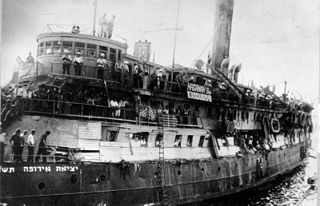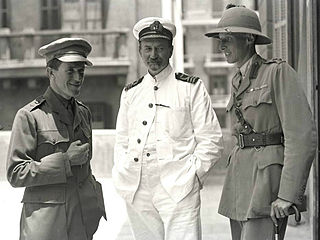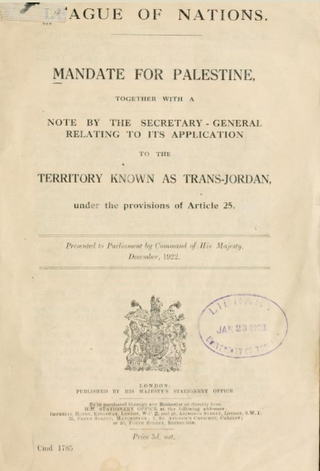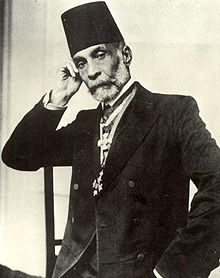
The Balfour Declaration was a public statement issued by the British Government in 1917 during the First World War announcing its support for the establishment of a "national home for the Jewish people" in Palestine, then an Ottoman region with a small minority Jewish population. The declaration was contained in a letter dated 2 November 1917 from the United Kingdom's Foreign Secretary Arthur Balfour to Lord Rothschild, a leader of the British Jewish community, for transmission to the Zionist Federation of Great Britain and Ireland. The text of the declaration was published in the press on 9 November 1917.

Chaim Azriel Weizmann 27 November 1874 – 9 November 1952) was a Russian-born biochemist, Zionist leader and Israeli statesman who served as president of the Zionist Organization and later as the first president of Israel. He was elected on 16 February 1949, and served until his death in 1952. Weizmann was instrumental in obtaining the Balfour Declaration of 1917 and convincing the United States government to recognize the newly formed State of Israel in 1948.
This is a partial timeline of Zionism in the modern era, since the start of the 16th century.

A homeland for the Jewish people is an idea rooted in Jewish history, religion, and culture. The Jewish aspiration to return to Zion, generally associated with divine redemption, has suffused Jewish religious thought since the destruction of the First Temple and the Babylonian exile.

Yishuv, HaYishuv HaIvri, or HaYishuv HaYehudi Be'Eretz Yisra'el denotes the body of Jewish residents in Palestine prior to the establishment of the State of Israel in 1948. The term came into use in the 1880s, when there were about 25,000 Jews living in that region, and continued to be used until 1948, by which time there were some 630,000 Jews there. The term is still in use to denote the pre-1948 Jewish residents in Palestine, corresponding to the southern part of Ottoman Syria until 1918, OETA South in 1917–1920, and Mandatory Palestine in 1920–1948.

The 1920 Nebi Musa riots or 1920 Jerusalem riots took place in British-controlled part of Occupied Enemy Territory Administration between Sunday, 4 April, and Wednesday, 7 April 1920 in and around the Old City of Jerusalem. Five Jews were killed and several hundred injured; four Arabs were killed, and eighteen injured; 7 Britons were injured. The riots coincided with and are named after the Nebi Musa festival, which was held every year on Easter Sunday, and followed rising tensions in Arab–Jewish relations. The events came shortly after the Battle of Tel Hai and the increasing pressure on Arab nationalists in Syria in the course of the Franco-Syrian War.

The Faisal–Weizmann agreement was signed by Emir Faisal, the third son of Hussein ibn Ali al-Hashimi, King of the short-lived Kingdom of Hejaz, and Chaim Weizmann, President of the Zionist Organization on 3 January 1919. Signed two weeks before the start of the Paris Peace Conference, it was presented by the Zionist delegation alongside a March 1919 letter written by T. E. Lawrence in Faisal's name to American Zionist leader Felix Frankfurter as two documents to argue that the Zionist plans for Palestine had prior approval of Arabs.
The Biltmore Conference, also known by its resolution as the Biltmore Program, was a fundamental departure from traditional Zionist policy by its demand "that Palestine be established as a Jewish Commonwealth." The meeting was held in New York City, at the prestigious Biltmore Hotel, from May 9 to May 11, 1942, with 600 delegates and Zionist leaders from 18 countries attending.

The White Paper of 1939 was a policy paper issued by the British government, led by Neville Chamberlain, in response to the 1936–1939 Arab revolt in Palestine. After its formal approval in the House of Commons on 23 May 1939, it acted as the governing policy for Mandatory Palestine from 1939 to the 1948 British departure. After the war, the Mandate was referred to the United Nations.
The Passfield White Paper, issued October 20, 1930, by colonial secretary Lord Passfield, was a formal statement of British policy in Palestine, which previously had been set by the Churchill White Paper of 1922. The new statement resulted from the Hope Simpson Commission's investigation into the deeper causes of the 1929 Palestine riots, that initially started over access to the Western Wall. The white paper limited official Jewish immigration to a much greater degree.

The 1921 Cairo Conference, described in the official minutes as Middle East Conference held in Cairo and Jerusalem, March 12 to 30, 1921, was a series of meetings by British officials for examining and discussing Middle Eastern problems, and to frame a common policy. The secret conference of British experts created the blueprint for British control in both Iraq and Transjordan. By offering nominal leadership of those two regions to the sons of the Sharif of the Mecca, Churchill felt that the spirit if not the actual letter of Britain's wartime promises to the Arabs were fulfilled.

The Haycraft Commission of Inquiry was a Royal Commission set up to investigate the Jaffa riots of 1921, but its remit was widened and its report entitled "Palestine: Disturbances in May 1921". The report blamed the Arabs for the violence, but identified a series of grievances concerning the way their interests were apparently being subsumed to the interests of the Jewish immigrants, who were then around 10% of the population and increasing rapidly. Some measures to ease Arab unhappiness were taken, but Jewish communities were helped to arm themselves and ultimately the report was ignored. Publishing it was considered a propitiatory measure.
The Palin Commission or Palin Commission of Inquiry or Palin Court of Inquiry was a British Royal Commission convened to investigate the cause of the 1920 Jerusalem riots, which took place between April 4, 1920 and April 7, 1920. The Commission was also tasked with investigating “the extent and causes of racial feelings that at present exist in Palestine”.

During the British rule in Mandatory Palestine, there was civil, political and armed struggle between Palestinian Arabs and the Jewish Yishuv, beginning from the violent spillover of the Franco-Syrian War in 1920 and until the onset of the 1948 Arab–Israeli War. The conflict shifted from sectarian clashes in the 1920s and early 1930s to an armed Arab Rebellion against British rule in 1936, armed Jewish Revolt primarily against the British in mid-1940s and finally open war in November 1947 between Arabs and Jews.

The Hogarth Message was a January 1918 message from Commander David Hogarth, head of the Arab Bureau in Cairo, to Hussein bin Ali, Sharif of Mecca, following Hussein's request for an explanation of the Balfour Declaration.
Albert Montefiore Hyamson, was a British civil servant and historian who served as chief immigration officer in the British Mandate of Palestine from 1921 to 1934.

The Mandate for Palestine was a League of Nations mandate for British administration of the territories of Palestine and Transjordan – which had been part of the Ottoman Empire for four centuries – following the defeat of the Ottoman Empire in World War I. The mandate was assigned to Britain by the San Remo conference in April 1920, after France's concession in the 1918 Clemenceau–Lloyd George Agreement of the previously agreed "international administration" of Palestine under the Sykes–Picot Agreement. Transjordan was added to the mandate after the Arab Kingdom in Damascus was toppled by the French in the Franco-Syrian War. Civil administration began in Palestine and Transjordan in July 1920 and April 1921, respectively, and the mandate was in force from 29 September 1923 to 15 May 1948 and to 25 May 1946 respectively.
The Palestine Arab Congress was a series of congresses held by the Palestinian Arab population, organized by a nationwide network of local Muslim-Christian Associations, in the British Mandate of Palestine. Between 1919 and 1928, seven congresses were held in Jerusalem, Jaffa, Haifa and Nablus. Despite broad public support their executive committees were never officially recognised by the British, who claimed they were unrepresentative. After the British defeat of Ottoman forces in 1918, the British established military rule and (later) civil administration of Palestine. The Palestine Arab Congress and its organizers in the Muslim-Christian Associations were formed when the country's Arab population began coordinated opposition to British policies.

Mandatory Palestine was a geopolitical entity that existed between 1920 and 1948 in the region of Palestine under the terms of the League of Nations Mandate for Palestine.
This is a timeline of intercommunal conflict in Mandatory Palestine.
















